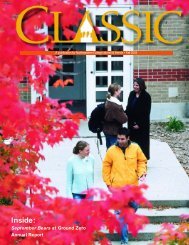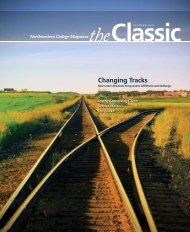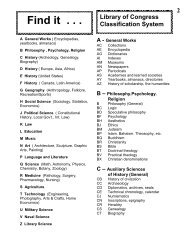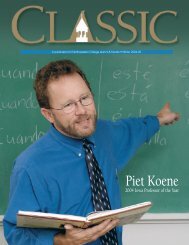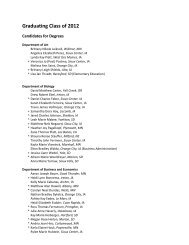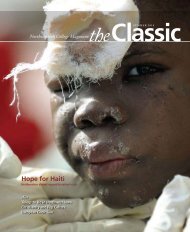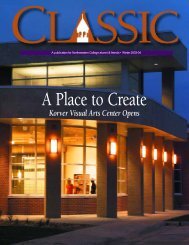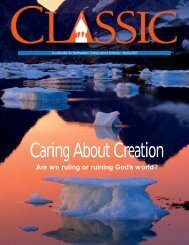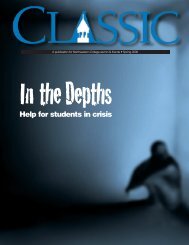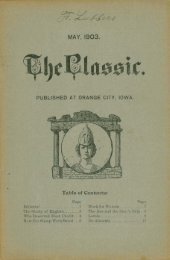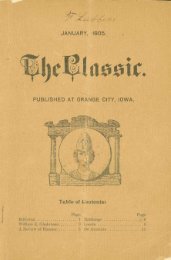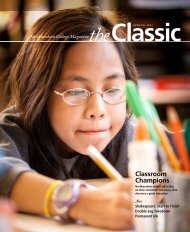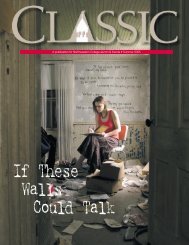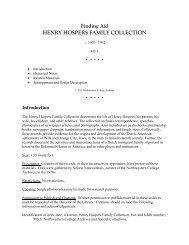Fall 2002 - Northwestern College
Fall 2002 - Northwestern College
Fall 2002 - Northwestern College
- No tags were found...
Create successful ePaper yourself
Turn your PDF publications into a flip-book with our unique Google optimized e-Paper software.
N o r t h w e s t e r n C l a s s i c<br />
A l u m n p iro f i l e<br />
Royal says the transition<br />
to life at <strong>Northwestern</strong><br />
was smooth because he felt<br />
God’s leading through every<br />
difficulty. He fondly<br />
remembers many people<br />
who provided him with<br />
support—faculty, staff,<br />
Orange City residents,<br />
American students and fellow<br />
members of the<br />
International Club.<br />
At <strong>Northwestern</strong>, Royal<br />
g rew spiritually thro u g h<br />
Bible studies, service pro j e c t s<br />
and the modeling of<br />
Christian faculty. “Because<br />
of <strong>Northwestern</strong> ’s stro n g<br />
Christian commitment, I<br />
a c q u i red a Christian worldview<br />
and was really pre p a re d<br />
to face the world,” he says.<br />
A biology major, Royal<br />
came to NWC desiring to<br />
become a medical missionary.<br />
He found that he<br />
enjoyed computer science<br />
courses, and struggled over<br />
whether he should switch<br />
his major. “I prayed about<br />
this for a week, and then<br />
went to First Reformed<br />
Church, where Pastor<br />
(Cecil) Martens prayed a<br />
line that said, ‘God, show us<br />
not only the reality, but also<br />
the possibility.’ The reality<br />
was that it is hard for international<br />
students to get into<br />
American medical schools.<br />
But it was possible, so I<br />
stayed with my biology<br />
major. God was planning<br />
the whole thing; I didn’t<br />
know what was going to<br />
pan out.”<br />
Royal was chosen to<br />
participate in a research<br />
project at Harvard Medical<br />
School the summer before<br />
his senior year, an experience<br />
that would prove to be<br />
pivotal. “It was very<br />
rewarding, but I realized<br />
that medical research suited<br />
me better than being a doctor,”<br />
he recalls. “I saw that<br />
it could be very stressful to<br />
be a physician, and I felt I<br />
wouldn’t enjoy that type of<br />
lifestyle.”<br />
After graduation, Royal<br />
enrolled in the master’s<br />
degree program in biophysics<br />
at the State<br />
University of New York at<br />
Buffalo. There, too, he<br />
sensed the Lord’s leading. A<br />
professor created a program<br />
for him that focused on<br />
platelet adhesion—what<br />
happens when an artificial<br />
surface such as a transplant<br />
comes into contact with the<br />
blood system. And, while<br />
there, Royal had the opportunity<br />
to minister to the<br />
university’s large international<br />
student community.<br />
When the university’s<br />
budget cutbacks necessitated<br />
Royal’s switching to a<br />
Ph.D. program, he gained<br />
an interest in non-invasive<br />
diagnostic instrumentation<br />
such as Magnetic Resonance<br />
Imaging (MRI). “A professor<br />
at Roswell Park Cancer<br />
Institute, which is affiliated<br />
with SUNY-Buffalo, was<br />
doing that, but he was planning<br />
to retire soon and not<br />
taking any more students. I<br />
prayed a lot and somehow<br />
persuaded him to take me<br />
as his last student.”<br />
Royal’s research on<br />
developing contrast enhancing<br />
techniques for MRI on<br />
brain tumors led to a postdoctoral<br />
research position at<br />
the University of California-<br />
San Francisco (UCSF).<br />
“They were doing another<br />
step further than we were—<br />
Nuclear Magnetic<br />
Resonance Spectroscopic<br />
Imaging. That enables you<br />
to tell a person’s cancer tissue<br />
chemical composition<br />
without biopsy. It was the<br />
hottest technology at the<br />
time, and UCSF was one of<br />
the best in the country,”<br />
Royal says.<br />
At UCSF, Royal worked<br />
with 200-300 prostate cancer<br />
patients. Many were<br />
▼<br />
“Because of <strong>Northwestern</strong> ’s<br />
s t rong Christian commitment,<br />
I acquired a<br />
Christian worldview and<br />
was really pre p a red to face<br />
the world.”<br />
▲<br />
celebrities who heard about<br />
his lab’s potential to determine<br />
the grade of cancer<br />
after former patient Andy<br />
Grove, CEO of Intel, mentioned<br />
it in a Fortune magazine<br />
article.<br />
When Royal’s son was<br />
born three months premature,<br />
Royal left UCSF, which<br />
had offered him an assistant<br />
professorship, to stay home.<br />
While tending to Joseph’s<br />
needs, Royal began doing<br />
consulting work. Using his<br />
computer science training<br />
from <strong>Northwestern</strong> and his<br />
biology knowledge, he<br />
developed state-of-the-art<br />
fingerprint verification and<br />
identification software.<br />
After a year at home,<br />
Royal became a scientific<br />
programmer for a firm that<br />
conducted genomic<br />
research. For the last three<br />
years, he has been with<br />
Caliper Technologies Corp.,<br />
another Silicon Valley company<br />
that combines computer<br />
industry technology<br />
with biotechnology.<br />
As senior scientific programmer,<br />
he develops algorithms<br />
for software used to<br />
process and analyze high<br />
throughput data. His work<br />
has contributed to Caliper’s<br />
“lab-on-a-chip” technology,<br />
which miniaturizes, integrates<br />
and automates many<br />
laboratory processes, putting<br />
them on a palm-sized<br />
chip. The chip contains a<br />
network of microscopic<br />
channels through which fluids<br />
and chemicals are<br />
moved in order to perform<br />
experiments.<br />
“The biggest use of labon-a-chip<br />
is by pharmaceutical<br />
companies trying to<br />
find a potential drug target,”<br />
explains Royal. “They will<br />
screen tens of thousands to<br />
a million compounds a year<br />
to find one or two targets, a<br />
very costly process. With<br />
this, they don’t have to<br />
spend a lot on chemicals; a<br />
tiny little bit is enough to<br />
do the reaction. And they<br />
are able to complete several<br />
months’ work of compound<br />
screening in a few days.<br />
“God was so good to<br />
me, leading me to this company,”<br />
says Royal. “Looking<br />
back, I was always praying,<br />
and God led me from one<br />
thing to another. It was<br />
continued on page 28<br />
2 1 ▲ F a l l 2 0 0 2



